|
|
|
|
Coordinate geometry
(or Analytic geometry) in three-dimensional space
|
|
|
|
Plane laid through a given point, such that be parallel with two skew lines
|
|
The normal vector of planes that are parallel with two skew lines is collinear to the vector product of |
|
direction
vectors of these lines, so we can write |
| N
= s1 ´
s2 |
| The plane passes through a given point if
the coordinates of the point A(x0,
y0,
z0) satisfy the equation of the
plane that is |
| Ax0 +
By0 + Cz0 + D
= 0 |
| this condition determines the parameter
D
of the plane to be found. |
|
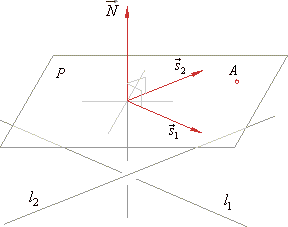 |
|
|
|
Example:
Given are skew lines, |
 |
and the point
|
|
| A(3, 2, 5),
lay a
plane through the given point parallel with the given lines.
|
|
|
Solution: From
the equations of the lines, s1
= 2i -
j +
4k and s2
= -3i
-
2 j + k,
so the normal vector of
the plane |
 |
| Plug the point
A
into the equation of the plane to determine D, |
| A(3, 2, 5)
=>
7x -
14y
-
7z + D = 0
=>
7 · 3
-
14 · 2 -
7 · 5
+ D = 0,
D =
42
|
|
therefore, the equation of the plane 7x
-
14y
-
7z + 42 = 0. |
|
|
Plane
laid through a given point, such that be parallel with two parallel
lines
|
|
In this case, the normal vector of
the planes, which are parallel with two parallel lines, is collinear with the |
|
vector
product of the direction vector of one line and the vector
T1T2
that represents the difference of the radius vectors
r2
-
r1, of any
of the points of the given lines, that is |
| N
= s1 ´
(r2
-
r1) |
|
The
given point M(x0,
y0,
z0)
is a point of the plane, so it
must
satisfy the condition,
|
| Ax0 +
By0 + Cz0 + D
= 0. |
|
And this is the way to determine the parameter
D
of the plane to be found.
|
|
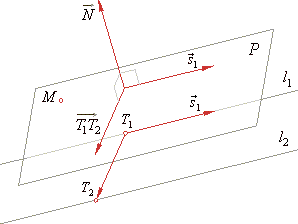 |
|
|
|
Distance between point and line
|
|
The
distance d
between a point and a line we calculate as the distance between the given point
|
|
A(x1,
y1,
z1) and its
orthogonal projection onto the given line using the formula for the distance
between two points. |
|
The projection of the point onto the line is at the same time the
intersection point A´(xp,
yp,
zp) of the given line and a plane which
passes through the given point orthogonal to the given line, thus |
 |
| where
d
is the distance between the given point and the given line. |
|
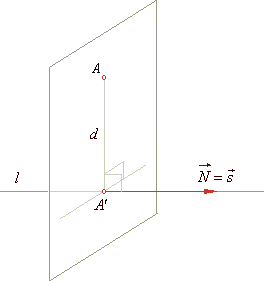 |
|
|
|
Example:
Find the distance between a point A(-3,
5, -2) and a line |
 |
|
|
Solution: Through the given point lay a plane perpendicular to the given line,
then |
| as
N =
s = -i -
j
and A(-3,
5, -2)
substituted into
P ::
- x
-
y + D
= 0 |
| gives
-1 · (-3)
-
1 · 5 + D
= 0,
D
= 2
therefore, the plane P
:: - x
-
y + 2 = 0. |
| Then,
rewrite the given line into the parametric form to get its intersection
with the plane P, |
 |
| plug
these variable coordinates of a point of the line into the plane to find
parameter t
that determine the intersection
point, |
| x
= - t
-
8 and y
= - t
=>
- x
-
y + 2
= 0 so
that - (-t
-
8) - (- t) +
2
= 0,
t
= -5 |
| therefore,
x
= - (- 5)
-
8
= -3
and y
= -t
= - (- 5)
= 5, the intersection A´(-3,
5, 0). |
| The
distance between the point A
and the line equals the distance between points, A
and A´
thus, |
 |
|
|
Distance between point and plane
|
| We
use the formulas for the distance from a point to a plane
that are given in the two forms |
| - the Hessian normal form,
d =
x0cosa
+ y0cosb
+ z0cosg
-
p |
| - and when a plane is given in general form, |
 |
|
| The distance between a point and a plane can also be calculated using the formula for the distance between
two points, that is, the distance between the given point and its orthogonal projection onto the given plane. |
|
|
Distance between parallel lines
|
|
Distance between two parallel lines we calculate as the distance between intersections of the lines and a
plane
orthogonal to the given lines.
|
|
The direction vector of the plane orthogonal to the given lines is collinear or coincides with their direction vectors
that is |
| N
= s = ai + b j + ck |
| By plugging any of two points, which are included in the equations of the given lines, into the equation of the plane,
determined is the parameter D, as well as determined is one
of the intersection points. |
|
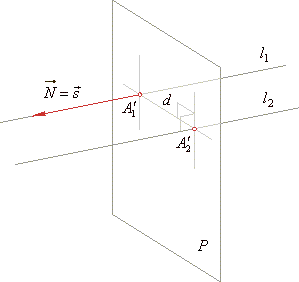 |
|
|
|
Example:
Find the distance between given parallel lines, |
 |
|
|
Solution: The direction vector of a plane orthogonal to
the parallel lines is collinear with the direction vectors of these lines, so
N =
s = 2i -
9 j - 2k.
|
| Let the plane passes through the point
A´2(-5,
-3,
6) of the second line, then
|
| A´2(-5,
-3,
6) =>
Ax +
By + Cz + D
= 0
or 2 · (-5)
-
9 · (-3) +
(-2)
· 6 + D
= 0,
D
= -5
|
| thus, the equation of the plane
2x
-
9y -
2z -
5 = 0. Besides, the point
A´2(-5,
-3,
6) is the intersection of the second line and the plane.
|
| The intersection of the first line and the plane
we calculate as follows,
|
 |
| The distance between the intersection points
A´1
and A´2
is at the same time the distance between given lines, thus
|
 |
|
|
Distance between two skew lines
|
|
Through one of a given skew lines lay a plane parallel to another line and calculate the distance between any
point of that line and the plane
|
|
The direction vector of planes, which are parallel
to both lines, is coincident with the vector product of
direction vectors of given lines, so we can write
|
| N
= s1 ´
s2
.
|
|
A plane to
lie on the one of the given lines,
we should plug the point, that is included into the
equation of the line, into the equation of the plane
and so determined
is the parameter
D
of the plane.
|
|
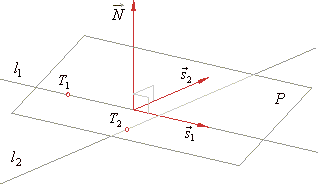 |
|
|
|
Example:
Find the distance between given skew lines, |
 |
|
|
Solution: Through the line
l1
lay a plane parallel to the line
l2. The direction vector of the plane,
|
 |
| The point included in the equation of the line
l1
must satisfy the equation of the plane, so
|
| P1(7, -10, -5)
=>
Ax +
By + Cz + D
= 0,
20 · 7 + (-4)
· (-10)
+ (-22)
· (-5)
+ D
= 0,
|
|
D
= -290 thus, the equation of the plane
20x
-
4y -
22z -
290 = 0.
|
| The distance between the point
T2(-6,
-1,
2), of the line
l2, and the plane which is parallel to it
|
 |
| The sign of the square root is taken to be opposite to the sign of the parameter
D.
Therefore, the negative value of the result only informs us that the point is positioned at the same side as
the origin of the coordinate system.
|
|
|
|
|
|
|
|
|
|
|
|
|
|
|
|
|
|
|
|
|
|
|
|
|
|
|
|
|
Contents C
|
|
|
|
|

|
|
|
|
|
|
Copyright
© 2004 - 2020, Nabla Ltd. All rights reserved.
|
|
|